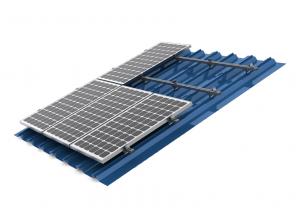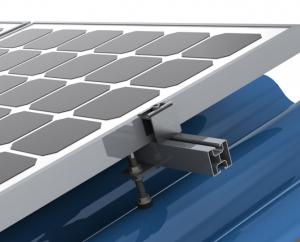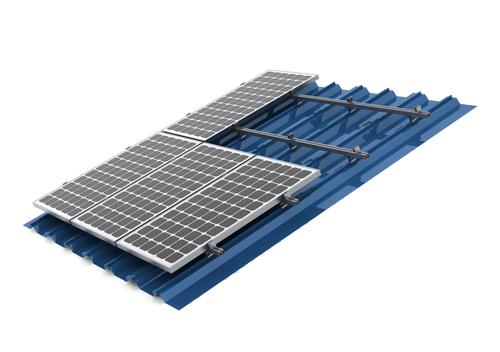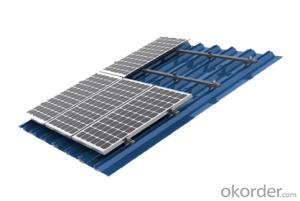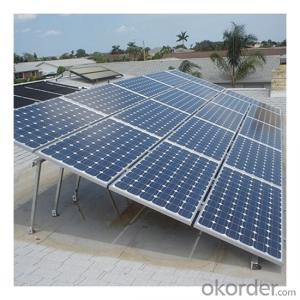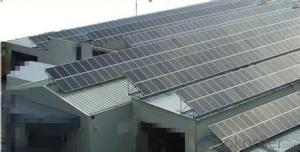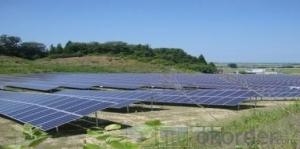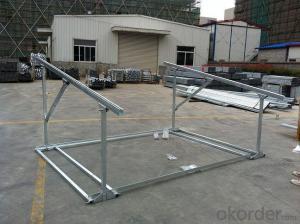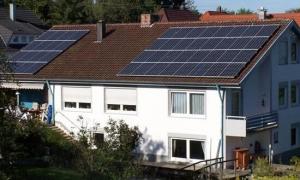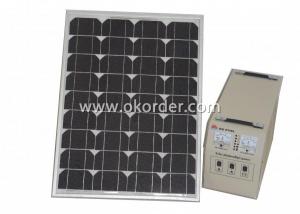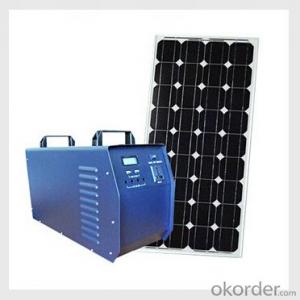Scudder Solar Energy Systems Solar Mounting Metal Sheet Roof System
- Loading Port:
- China Main Port
- Payment Terms:
- TT or LC
- Min Order Qty:
- -
- Supply Capability:
- -
OKorder Service Pledge
OKorder Financial Service
You Might Also Like
Product Features
• Less piece of components and easy for installation.
• Design speical clamp matching to the metal sheet shape and specification.
• Use super quality Al-alloy and stainless steel for components.
• Wide range of product line .
Technical Data
Installation site Metal sheet roof
Slope of roof Client requirement
Module specification Frame / frameless module, crystalline/thin film module
Installation type Parallel to the roof
Module arrangement Portrait Landscape
Module area square Client requirement
Module area position Client requirement
Roof structure Client requirement
Loading section Al 6063 T5
Small pieces Stainless steel, Al6063 T5
- Q: Can solar energy systems be used for desalination?
- Yes, solar energy systems can be used for desalination. Solar-powered desalination systems use solar energy to power the desalination process, typically through solar thermal or solar photovoltaic technologies. This renewable energy source offers a sustainable and environmentally friendly solution for producing freshwater from seawater, making it a viable option for areas with limited access to clean water.
- Q: Can solar energy systems be used in areas with limited access to solar inverters?
- Yes, solar energy systems can be used in areas with limited access to solar inverters. In such cases, alternative solutions like micro-inverters or power optimizers can be employed to convert the DC power generated by solar panels into usable AC power without the need for a centralized inverter. These technologies enable more flexibility in system design and can be particularly useful in remote or off-grid locations with limited access to traditional solar inverters.
- Q: Can solar energy systems be used in areas with limited access to solar energy insurance coverage?
- Yes, solar energy systems can still be used in areas with limited access to solar energy insurance coverage. While insurance coverage may provide financial protection in case of damage or malfunction, it is not a requirement for the installation and operation of solar energy systems. However, it is advisable to thoroughly assess potential risks and consider alternative risk management strategies in the absence of proper insurance coverage.
- Q: Can solar energy systems be used for powering hotels or resorts?
- Hotels and resorts can definitely utilize solar energy systems to power their operations. These systems have the ability to convert sunlight into usable energy, producing electricity that can be used for various purposes. Installing solar panels on the roofs or suitable areas of these establishments enables the generation of clean and sustainable energy. By harnessing solar power, hotels and resorts can decrease their reliance on traditional electricity sources, which often come from non-renewable resources. This offers a greener alternative, helping these establishments reduce their carbon footprint and contribute to a more sustainable future. Additionally, hotels and resorts often have ample surface areas that are suitable for solar panel installations. This makes them an ideal location for generating solar power, as the large rooftop spaces and open areas can accommodate a significant number of solar panels, thus increasing the electricity generation capacity. Solar energy systems can power various aspects of hotels and resorts, such as lighting, heating, cooling, and even electric vehicle charging stations. Some establishments may even generate excess energy, which can be fed back into the power grid and generate revenue through net metering or feed-in tariffs. In addition to the environmental benefits, solar power can also provide economic advantages for hotels and resorts. Although the initial cost of installing solar panels may be high, the long-term savings on electricity bills can be substantial. Over time, the investment in solar energy systems pays off, leading to lower operational costs and increased profitability. Moreover, integrating solar power into hotels and resorts can enhance their brand image and attract environmentally conscious customers. Many travelers today prioritize sustainable and eco-friendly accommodations, and offering solar-powered facilities can serve as a significant selling point. In conclusion, solar energy systems can effectively power hotels or resorts. By embracing solar power, these establishments can reduce their environmental impact, save on energy costs, and appeal to eco-conscious customers.
- Q: How do I monitor the performance of my solar energy system?
- To effectively monitor the performance of your solar energy system, there are several key steps you can follow: 1. Install a monitoring system: First, ensure that your solar energy system is equipped with a monitoring system. This typically involves installing a monitoring device or software that collects and analyzes data from your solar panels, inverters, and other components. Many solar energy systems come with built-in monitoring capabilities, so check with your manufacturer or installer to see if this is already included. 2. Track energy production: Monitoring the energy production of your solar panels is essential to assessing their performance. The monitoring system should provide real-time information on the amount of electricity your solar panels are generating. This data can help you identify any issues or discrepancies in energy production, such as shading or malfunctions, and take appropriate action. 3. Monitor energy consumption: Understanding your energy consumption patterns alongside solar energy production allows you to optimize your system's performance. Consider installing a smart meter or energy monitoring device that tracks your household's energy usage. By comparing energy production and consumption data, you can determine if your system is generating enough electricity to meet your needs or if adjustments are required. 4. Analyze historical data: Regularly reviewing historical data from your monitoring system can provide valuable insights into the long-term performance of your solar energy system. Look for trends, such as seasonal variations in energy production, and compare it to your energy needs. This analysis can help you make informed decisions about system upgrades, maintenance, or future expansions. 5. Set performance benchmarks: Establishing performance benchmarks allows you to measure the effectiveness of your solar energy system. Compare your system's actual energy production against predicted or expected values. If there is a significant deviation, it might indicate a problem with your system that needs to be addressed, such as faulty equipment or suboptimal installation. 6. Regular maintenance and inspections: Conducting regular maintenance and inspections of your solar energy system is crucial for optimal performance. This includes cleaning the solar panels to remove dirt or debris, checking for any physical damage, and ensuring that all components are functioning properly. Monitoring system alerts or notifications can help you identify maintenance needs or potential issues early on. 7. Seek professional assistance if needed: If you are unsure about monitoring your solar energy system or encounter persistent performance issues, it is advisable to seek professional assistance. Solar energy system installers or technicians can help troubleshoot problems, provide guidance on monitoring systems, and suggest improvements to optimize your system's performance. By following these steps, you can effectively monitor your solar energy system and ensure it performs optimally, maximizing the benefits of renewable energy generation.
- Q: Is it possible to store excess electricity generated by a solar energy system?
- Excess electricity generated by a solar energy system can indeed be stored. One way to do this is by using batteries, which are commonly employed for this purpose. Battery banks can be integrated into solar energy systems to store surplus electricity produced during the day, allowing it to be utilized at night or during periods of low sunlight. By charging and discharging as necessary, these batteries ensure a consistent and dependable power supply, even in the absence of sunlight. Another means of storing excess electricity is through grid-tied systems. In this configuration, any surplus power generated by the solar energy system is fed back into the electrical grid. The excess electricity is then credited to the homeowner's account, enabling them to draw power from the grid during times when their solar panels are unable to generate enough energy, such as at night or on cloudy days. Both battery storage systems and grid-tied systems offer effective solutions for storing and utilizing surplus electricity generated by solar energy systems. These methods ensure that no energy is wasted and enable homeowners to enjoy a reliable and uninterrupted power supply.
- Q: Can solar energy systems be used in areas with limited access to solar surge protection devices?
- Yes, solar energy systems can still be used in areas with limited access to solar surge protection devices. While surge protection devices are recommended to protect solar panels and equipment from sudden voltage spikes, their absence does not render the entire system unusable. Other protective measures, such as grounding the solar installation, using appropriate circuit breakers, and employing surge protection at the building's electrical panel can still help mitigate potential risks. Additionally, regular maintenance and monitoring of the system can help identify and address any potential issues.
- Q: Can solar energy systems be used in commercial buildings?
- Yes, solar energy systems can definitely be used in commercial buildings. In fact, they are increasingly being adopted by businesses worldwide as a sustainable and cost-effective solution for meeting their energy needs. Solar panels can be installed on the rooftops or facades of commercial buildings, harnessing the power of the sun to generate electricity. This clean and renewable energy source not only helps reduce greenhouse gas emissions but also provides long-term energy savings for businesses.
- Q: What are the main features of solar photovoltaic systems
- Compared with the commonly used thermal power generation system, the advantages of photovoltaic power generation:No danger of depletion; safe and reliable, no noise, no pollution, absolutely clean (pollution-free); not subject to geographical distribution of the resources, can take advantage of the building roof; for example, areas without electricity, and complex terrain area; no fuel consumption and the erection of transmission line can be on-site power supply high quality energy;; users emotionally receptive; the construction period is short, get energy to spend a short time.
- Q: Can solar energy systems be used for powering electric vehicle charging stations?
- Yes, solar energy systems can be used to power electric vehicle charging stations. Solar panels can generate electricity from sunlight, which can then be used to charge electric vehicles. This not only reduces the reliance on fossil fuels but also helps in promoting clean and renewable energy sources for transportation.
Send your message to us
Scudder Solar Energy Systems Solar Mounting Metal Sheet Roof System
- Loading Port:
- China Main Port
- Payment Terms:
- TT or LC
- Min Order Qty:
- -
- Supply Capability:
- -
OKorder Service Pledge
OKorder Financial Service
Similar products
Hot products
Hot Searches
Related keywords
